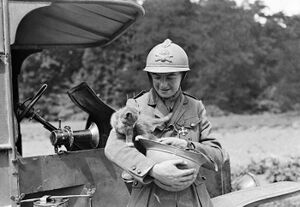Syaran Army Auxiliary Corps
| Syaran Army Auxiliary Corps | |
|---|---|
 Insignia of the PKAS | |
| Active | 1916 - 1947 |
| Country | |
| Branch | Army of the Syaran Republic |
| Type | Military reserve force |
| Role | Civil defense |
| Size | 4,350,000 (1937) |
| Auxiliary Corps Supreme Headquarters | Zovahr |
| Nickname(s) | The Syaran Auxiliary |
| Patron | Zarina |
| March | "Auxiliary March" |
| Engagements | Syaran intervention in the Ruvelkan Civil War Divide War Siduri War |
The Syaran Army Auxiliary Corps (Syaran: Помошен корпус на армијата Сјаран, Pomošen korpus na armijata Sjaran), abbreviated as PKAS, was a Military reserve force of the Army of the Syaran Republic (ARS) from 1916 to 1947. Ostensibly designed to serve as a secondary force composed of soldiers not fit for active duty, the PKAS essentially became the women's branch of the ARS, intended to fill roles that freed up manpower for front line forces. At its peak in 1937 the PKAS was composed of 4,350,000 personnel, roughly four million of them women.
History
After the Syaran-Ruvelkan War the Supreme Headquarters of the ARS identified a need to transfer support and logistical roles, such as nursing, signals, transportation, and supply, away from the burden of front line division to free up troops for the infantry, artillery, and the newly established Syaran Army Air Corps. Plans were put into place for the formation of a military reserve force, first coined the Syaran National Auxiliary, in 1913, but it wasn't until the Divide War that the the organization was officially stood up as the Syaran Army Auxiliary Corps. The Desopya Campaign resulted in the first instance of mass conscription to support the PKAS. Prior to 1916 Syaran women were exempt from military service, but the invasion of Makedon force the ARS to begin drafting women en masse, especially those with experience or education in fields such as medicine.
Approximately 400,000 people were conscripted or pressed into service for the PKAS. PKAS was not intended to be purely a women's force, rather it was supposed to be composed of both women and men who were, for various reasons, unable to serve in a more prominent capacity. As the standards and expectations of the ARS changed in the interwar era however there grew a more pressing need for manpower to support the expanded army, which in turn necessitated a larger logistical chain to support the growing force. The outbreak of the Siduri War brought about the most significant changes to the PKAS; the massive scale of the war required copious amounts of personnel in order to both fulfill the logistical demands of the war but also to free up as many military aged males for service.
War time drafting began in May 1935 with the conscription of more than 700,000 women, mostly young single women or women without children. An additional call up of 250,000 more in October 1935 was then followed by drafts of more than 1 million between November 1935 and January 1936. By the summer of 1936 more than 2.5 million women were serving with hundreds of thousands of more being drafted each month. At its peak in late 1937 the PKAS numbered nearly 4.5 million personnel, approximately four million of them women. Exact numbers are not known for the size of the PKAS by the time of the Treaty of Debrecen, as a result of breakdowns in recruitment, organization, and morale that plagues the ARS in the final months of the war.
Like the ARS, the PKAS was intended to be disbanded and demobilized once the fighting had ended. However numerous regiments of the PKAS were kept in service by the Common Axis during the Occupation of Syara, mostly units who services were still of value to post-war reconstruction and the occupying powers, such as signals, medicals, and transportation. The PKAS was officially dissolved in 1947 not long after the end of the Great Eracuran War.
Organization
The PKAS was subservient to the ARS and managed through the Auxiliary Corps Supreme Headquarters in Zovahr. The highest internal position of the PKAS was the Auxiliary Corps Senior Commander, who answered to the General Staff of the ARS. The structure of the PKAS followed largely followed the ARS. Underneath the Supreme Headquarters were Army Groups, named after Hellenic Deities. These were Army Group Athena (western Ruvelka), Army Group Artemis (eastern Ruvelka), Army Group Hekate (Hayreniky, southern Ruvelka), Army Group Demeter (Galania), and Army Group Hestia (Scitaria). Underneath Army Groups were Regional Commands, assigned to geographic regions within their area of operations. Underneath the Regional Commands the structure grew more ad hoc and dependent on the roles the PKAS troops were expected to fill. Officially the Regional Commands controlled Auxiliary Divisions, which in turn consisted of regiments, and independent battalions, but because the mission of each division varied depending the geography and strategic situation the actual structure at the division and below became much more fluid.
The rank structure of the PKAS was identical to the ARS with the exception of the addendum of "Auxiliary" before each rank title ("Auxiliary Sergeant" or "Auxiliary Captain"). This largely correlated to the same levels of command within the ARS; Captains commanded companies, Colonels commanded regiments, and major generals commanded divisions. Because it was deemed a reserve force, the PKAS was officially subordinate to ARS field commanders, and equivalent ranks held in the ARS were given more weight and authority. Despite this it was considered a breach of military discipline for a lower ranking ARS soldier to give orders to a higher ranking PKAS soldier; effectively, an ARS Private could command a PKAS Private, but could not issue lawful orders to a PKAS Captain, while a PKAS Captain could not issue orders to an ARS Captain. In practice however, ARS commanders exercises more or less total control over PKAS forces within their area of operations.
The regiment was the most commonly associated unit of organization for the PKAS and fulfilled specific roles. Chief among these were signals, anti-aircraft artillery, air watch, air traffic controller, medical, transportation, maintenance, and clerical duties. In practice a PKAS regiment was much smaller than its ARS equivalent; while an ARS regiment numbered around 2,500 troops, a PKAS regiment usually numbered only a few hundred. Regiments were grouped in divisions that handled various logistical needs for a specific area. These were known simply as Auxiliary Divisions, and were numbered like normal ARS divisions. A total of 81 Auxiliary Divisions were officially stood up throughout the Siduri War.
Personnel
The chief target demographic of the PKAS were young unmarried women, of which their was an abundance of during the Siduri War due to the mass conscription and departure of nearly ten million Syaran men. The conscription process was largely the same for PKAS troops; upon reaching the age of 18 a woman would be registered with the draft office and if needed ordered to report at her local recruiting station. In-processing involved having their personal information recorded, being fitted for and issued uniforms, inoculated against infectious diseases, and dispatched to basic training. Training took on abbreviated form of standard ARS training, with less focus on marching and weapons handling beyond the basics and more focused on familiarization with the Army and its rank structure and organization. Physical fitness regimes were implemented as many women would be expected to work hauling ammunition and unloading and loading supplies for transportation.
Women with existing skillets, such as typists, medical knowledge, and driving were pre-assigned to specific units upon completion of training whereas women in need of training were dispatched to specific training sites to develop their skills. For those who did not posses needed skills prior to enlistment, their occupation was chosen by lottery. Officers were selected from women who had prior education, much like their male counterparts. Once training was complete, the women would be given orders and transportation to their assigned units. Although much of the officer corps of the PKAS were men, women-dominated command teams were still common place, and virtually all-female units were numerous. Work duties, though largely focused on administrative, logistical, and support functions rather than combat, were modeled on ARS standard; squads, sections, platoons, were expected to be billeted together and work together in their mission, while officers and NCOs were held responsible for the actions of their subordinates. This extended to disciplinary actions; more than one thousand women were court-martialed and dishonorably discharged for various reasons during the Siduri War.
Although they were intended to avoid combat, more than 31,000 PKAS personnel were killed over the course of the war. Another 78,000 were wounded. The Republic officially awarded 6,755 medals for acts of bravery, including 132 recipients of "Hero of the Republic", the highest honor bestowed upon Syaran citizens.
Roles
The primary aim of the PKAS was to alleviate large numbers of men that were needed for front line service by transferring non-combat roles away from the ARS. Originally this was focused on administrative areas, such as file clerks, typists, postal services, but this gradually developed into numerous logistical functions. The need for transportation of both vehicles and aircraft resulted in hundreds of thousands of women being taught how to drive and fly aircraft. Medical services were also expanded to include hundreds of thousands of female nurses and doctors, while maintenance sections for vehicles and weapons were also filled by the PKAS. Engineering regiments and construction crews, especially for repairing road and railways, were stood up by the dozen, as were signal regiments for monitoring radios, telegraphs, and Morse code. More specialized units, like RADAR operations, were also assigned to high priority stations and military installations.
Arguably the best know were the anti-aircraft artillery regiments. Originally a low priority, the threat of Common Axis bombing campaigns against Syara resulted in the formation of hundreds of anti-air units to protect Syaran airspace from Common Axis bombers. Unlike most other PKAS personnel who were expected to only have a passing familiarity of weapons in order to avoid accidental discharges and mishandling, AAA crews were expected to be innately familiar with their equipment, and failure to meet standards for crew drills were grounds for punishment. Manning anti-aircraft guns was often the most difficult and dangerous roles the PKAS took on; of the 31,000 PKAS soldiers killed during the Siduri War, an estimate 20,000 were anti-aircraft gun crews.
